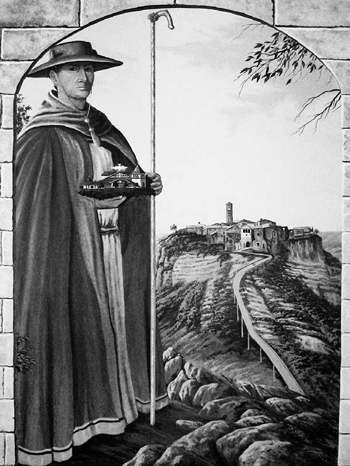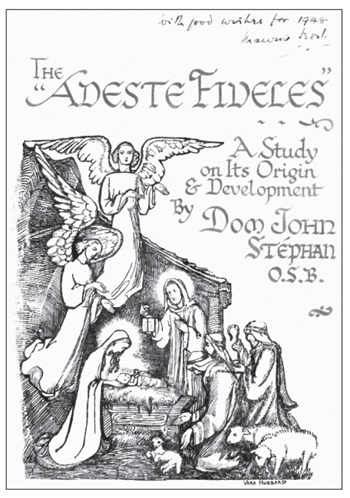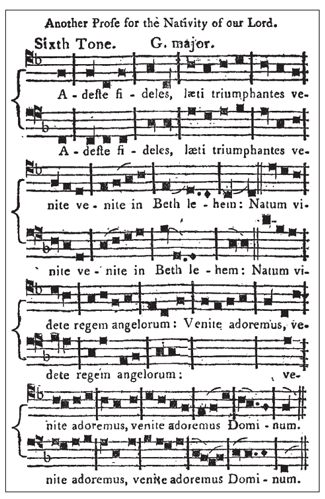Why was the Partridge in the Pear Tree? (10 page)
Read Why was the Partridge in the Pear Tree? Online
Authors: Mark Lawson-Jones

Mendelshohn’s setting to ‘Hark! the Herald Angels Sing’.
Some carols and songs enjoy popularity for a time and then disappear from common use, however it’s fair to say that ‘Hark the Herald’ has always enjoyed significant popularity and is sung widely still. In his
Anglican Hymnody
, published in 1885, the Revd James King examined fifty-two hymnbooks in use throughout the worldwide Anglican Communion and found ‘The Great Four’ hymns that appeared at least fifty-one times. They were:
1.
All Praise to thee, my God this night (Thomas Ken)
2.
Hark the Herald Angels Sing (Charles Wesley)
3.
Lo, He comes with clouds descending (Charles Wesley)
4.
Rock of Ages cleft for me (Augustus Montague Toplady)
In 2006, a survey for a radio station found that the carol is still popular, ranking third in a poll of 37,000 people. Their 2001 survey put the carol at sixth place. Classic FM (2006)
In churches, the hymn is sung at the end of Christmas services and continues to be loved by many.

O Come All Ye Faithful
O come, all ye faithful,
Joyful and triumphant,
O come ye, O come ye to Bethlehem;
Come and behold him,
Born the King of angels;
Refrain
O come, let us adore him,
O come, let us adore him,
O Come, let us adore him, Christ the Lord.
God of God,
Light of Light,
Lo! He abhors not the Virgin’s womb:
Very God,
Begotten, not created.
Sing, choirs of angels,
Sing in exultation,
Sing, all ye citizens of heaven above;
Glory to God
In the highest.
Yea, Lord, we greet thee,
Born this happy morning;
Jesus, to thee be glory given;
Word of the Father,
Now in flesh appearing; Refrain
Many Christmas carols and songs were written in times of great struggles, political, economic or military. They often tell more than the incidents surrounding the birth of Jesus Christ 2,000 years ago, giving us a picture of the concerns of people who lived hundreds of years ago. Some carols are written in the hope that they will encourage people to solve the problems of the present, they are also a rallying call to the likeminded to stand up and be counted.

St Bonaventure.
There is no better example of this than the carol, ‘Adeste Fideles’ that we know more commonly as ‘O Come all ye Faithful’. The history of this particular carol was shrouded in mystery and both the lyrics and the music have been the subject of intense speculation and research for many years.
The lyrics, from time to time, have been attributed to St Bonaventure, the thirteenth-century Italian scholar. They have also been attributed to Cistercian monks; some have said they are Portuguese in origin, some German and some Spanish.
The music has received no less speculation, being attributed first to the seventeenth-century English organist John Reading, and then his son. The famous composer of operas, oratorios and concertos, George Frideric Handel, has also received some attention from those anxious to discover the truth behind the music, as have many others. For a time, the Portuguese musician Marcos Antonio da Fonseca was in the frame, until it was realised that he was born twenty years after the first publication of the music.
The mystery of the music and the lyrics was almost solved in 1946, when the Revd Maurice Frost of Oxford, discovered a new manuscript of the hymn. Sadly the cover was missing so there were no signatures or publishing marks. The manuscript was described as a ‘Choir book, Medieval manuscript on paper. 92 leaves, written in red and black musical notation’, with a reference to ‘
Regem nostrum Jacobum
’ (‘Our King James’). Someone had also written the words ‘
regem angelorum
’ which is quite close to ‘
regem Angliorem
,’ (‘King of England’). The new discovery shed a whole new light on the lyrics and music, however with the missing front cover more detective work was needed.
At the beginning of 1947, a Benedictine monk in Buckfast Abbey, Devon, published a thirty-two page report, which has almost certainly settled the matter. Dom John Stephan OSB, started his study after the discovery the manuscript, and even though there were many questions left unanswered, he started to obtain photographs of all the early versions of the carol. He was curious about the fact that in the manuscript the mention of King James came immediately before ‘Adeste Fideles’. His attention first focussed on the discovery by the Revd Frost.
The dealers who sold the manuscript had dated it to around 1687, which if correct, would mean that the copy of the carol was at least fifty years older than any other in existence. They had decided the age based on the presence of the Jacobite statement about the King, therefore they believed it was when James II was still on the throne of England.

The cover of Dom John Stephen’s study of ‘Adeste Fideles’.
Dom Stephan’s first reaction to this claim was that the James referred to need not necessarily be James II, but might well be ‘James III’, the Old Pretender, who lived until 1765, and had devoted followers all through that period. After closely examining the watermarks of the paper used for the writing, he confirmed the accuracy of his suspicion. The end-paper used for the cover bore the date ‘1795’, but the rest of the book had different watermarks, which were traced by an expert to a period between 1720 and 1750.
The earliest copies of the ‘Adeste’ all bear the signature of John Francis Wade, so the next step was to examine the photographs. On looking at the first of these photographs, Dom Stephan was immediately struck by the similarity of the handwriting with that of the new ‘Jacobite’ manuscript. Other copies corroborated the exciting new finding.
With this new evidence, he contacted the Revd Frost to point out the coincidence. There was no escaping the conclusion to be drawn from this comparison of handwritings: the new manuscript was the product of the same scribe. Further investigation finally uncovered the scribe as a professional music-copyist who lived and worked at Douai, a flourishing town in France, twenty miles south of Lille.
In the Middle Ages, the strongly fortified town of Douai had flourished, numbering 30,000 inhabitants. Soon after, it became famous for its university, which dates from 1559, and a college founded by Cardinal Allen in the reign of Queen Elizabeth I. To English Catholics, the name Douai was recognized as the place where the majority of clergy were educated when their faith was outlawed in England. It was the place that they felt was preserving the faith, and protecting their traditions. Several other British establishments were founded there, colleges for the Scots and the Irish, and Benedictine and Franciscan monasteries. Douai was the chief centre for those who were exiled for their faith and a considerable number of English Catholics were influential in the university. Several chief posts were held by Englishmen and the first chancellor was Dr Richard Smith, formerly of Merton College, Oxford.
The scribe of the manuscript had been found, the story had taken a new turn and the story of this Christmas favourite had become intermingled with persecution, injustice and intrigue from the Middle Ages.
The scribe invariably signed and dated every one of his books with the original author of ‘Adeste Fideles’, the carol we know as ‘O Come all ye Faithful’. With the copy discovered by the Revd Frost bearing the same text and the watermark of the paper confirming the date, Dom Stephan was confident to declare that the original author of the carol was a Catholic layman, John Francis Wade, who was born in 1711.
Wade originally wrote the carol in Latin, giving it the title ‘Adeste Fideles’, the following verses correspond to the English verses:
Adeste fideles laeti triumphantes,
Venite, venite in Bethlehem.
Natum videte
Regem angelorum.
Venite adoremus (ter) Dominum.
Deum de Deo, lumen de lumine,
Gestant puellae viscera.
Deum verum, genitum non factum.
Venite adoremus (ter)
Dominum.
Cantet nunc ‘Io’, chorus angelorum;
Cantet nunc aula caelestium,
Gloria! Gloria in excelsis
Deo!
Venite adoremus (ter)
Dominum.
Ergo qui natus die hodierna.
Jesu, tibi sit gloria,
Patris aeterni
Verbum caro factum.
Venite adoremus (ter)
Dominum.
Wade fled to France during the final Jacobite rising of 1745. Britain and Ireland had been in political turmoil for nearly a century, and the rising of 1745, known as ‘The Forty-Five’, was an attempt by Charles Edward Stuart to regain the throne for the exiles House of Stuart. Charles, known as ‘Bonnie Prince Charlie’ sailed to Scotland and raised the Jacobite flag at Glenfinnan in the Highlands. The army marched south and won several battles, as they gathered momentum they entered England, reaching Derby, but the battles grew harder and they were recalled to Inverness, where the last battle on British soil took place at Culloden. As Bonnie Prince Charlie fled with a price on his head to permanent exile in France, so did John Francis Wade, and many other Catholics, who believed that all was lost.
The words of ‘Adeste Fideles’ are a heartfelt plea for France to invade and restore the Catholic traditions and end the persecutions, led by Bonnie Prince Charlie and the secret followers of the Old Pretender James Francis Stuart, Prince of Wales, the deposed son of James II. In the words, the ‘faithful’ are the ‘Jacobites’ who are being encouraged to return, and Bethlehem, was a code for them to mean England. So this was a carol of rallying the people to return.
In his study, Dom Stephan noted that he had uncovered twenty-seven different versions of ‘Adeste Fideles’, and he felt that his list was ‘far from complete’. He remarked also that ‘One or other [version] will be found in every hymn book in the English language, and the same remark applies to hymn books in other tongues. It is probably one of the very few hymns that has found a place in every collection of Christian hymns. What greater praise could one bestow on it? And there is no sign that its vogue is likely to die out.’ He goes on to write ‘Another tribute which singles it out from all other hymns is the fact that, as far as the present writer is aware, no alternative melody has been attempted to supplant the original one. For these two reasons, John Francis Wade must be considered as one of the greatest hymn-writers in the world, even if he only has one composition to his credit.’

